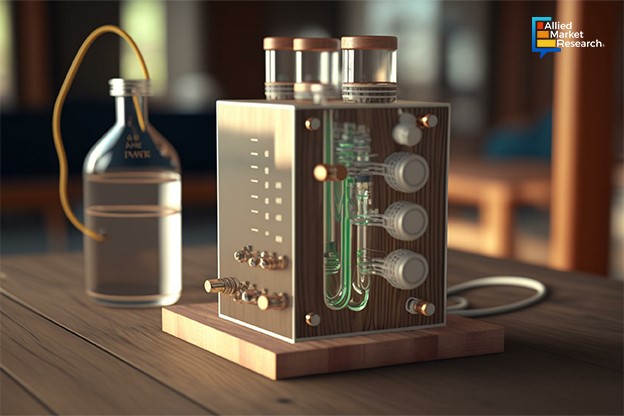How Can Opting for the Right Electrolyzers Help Your Business Meet Net-Zero Goals?

10 Feb
2024
Focal Points:
- Major types of electrolyzers
- Various industrial and commercial application of electrolyzers
- Notable acquisitions in the domain
- A greener future and electrolyzers
With the growing concerns of environmental issues, the world is undergoing a clean energy transition. Green hydrogen can act as a greater alternative to fossil fuels that can help businesses reduce their carbon footprint effectively. An electrolyzer is a device that uses renewable sources of energy such as wind, solar, hydroelectric power, or certain biofuels to power the production of green hydrogen. While using hydroelectric power, an electrolyzer uses an electric current to split water molecules and produce hydrogen and oxygen gases. Apart from serving as a great alternative to fuels, green hydrogen can play an important role in the production of green ammonia, methanol, and other chemical compounds that can help adopt sustainable agricultural practices, seaborne shipping, and chemical production. Furthermore, the electrolyzers producing green hydrogen can also be used for long-term energy storage, producing hydrogen that can be used in pressurized vessels for later use. In this article, we will discuss the latest types of electrolyzers that can help generate hydrogen gas efficiently, enabling industries to adopt green fuels.
Different types of electrolyzers benefiting industries adopting green energy:
Among renewable sources, water is widely used in electrolyzers to produce hydrogen gas. Based on water electrolysis technology, there are three major types of electrolyzers including proton exchange membrane, alkaline, and solid oxide electrolyzers. Proton exchange membrane (PEM) electrolyzers use solid polymer electrolytes as they contain a proton exchange membrane. When an electrical current is applied to a cell stack during water electrolysis, the water molecules split into hydrogen and oxygen. Such electrolyzers run usually at ideal temperatures of 60 degrees to 80 degrees Celcius.
The other major type of electrolyzer is an alkaline electrolyzer which contains water and a liquid electrolyte solution such as sodium hydroxide or potassium hydroxide. These electrolyzers run just below 100 degrees Celsius. In this elecrolyzer, when current is applied to an alkaline cell tack the hydrogen gas bubbles are generated at the cathode, and the oxygen gas is generated at the anode.
On the other hand, solid oxide electrolyzers are solid oxide fuel cells that use solid oxide, or ceramic, electrolytes. In such electrolytes, when current is applied, and water is fed into its cathode, the water gets converted into hydrogen gas and oxide ions. In these electrolyzers, hydrogen gas is captured for purification and the oxide ions move to the anode and release electrons to an external circuit to release oxygen gas.
Role of electrolyzers in industrial and commercial applications:
Nowadays, green hydrogen generated from electrolyzers can be used in fueling stations that can fuel e-mobility, larger vehicles, and forklifts. Many gas stations are dispensing refined diesel or gasoline to vehicles and electric charge stations for battery-powered vehicles. However, hydrogen fuel stations can serve to fuel huge material handling systems across the world with greater efficiency.
On the contrary, green hydrogen can be widely used for producing ammonia. Currently, 70% of ammonia is made from natural gas and the rest comes from coal. This can fuel drastic climatic changes. In a recent survey, the production of non-green ammonia can result in twice the emissions as that of produced from crude steel production and four times that of cement. However, ammonia produced from green hydrogen can mitigate greenhouse emissions and help make food-making ammonia fertilizer more sustainable.
Advancing hydrogen technologies: Some profitable acquisitions
The global electrolyzer industry is experiencing significant growth and is predicted to grow at a stunning CAGR of 27.2% from 2023 to 2032. To encourage healthy energy generation, many players in the domain have made profitable alliances. For instance, in October 2023, John Cockerill Hydrogen, a leading electrolyzer manufacturer announced its acquisition of manufacturing space in Baytown, a new hydrogen electrolyzer gigafactory capable of producing 1GW of electrolyzers per year. This acquisition would help leverage the hydrogen production experience of John Cockerill through its other plants in China and Europe.
Similarly, Cummins Inc., an American multinational corporation announced its acquisition of Hydrogenics Corporation, a developer and manufacturer of hydrogen generation and fuel cell products based on water electrolysis. With this acquisition, Cummins aimed to expand its product portfolio by making investments in hydrogen technologies, stepping ahead for decarbonizing the world.
Can electrolyzers lead to a greener future?
According to research and studies, eLectrolyzers can play a major role in the decarbonization efforts of countries and industries across the globe. The ability to store hydrogen gas for a longer period makes them ideal for various industrial processes and applications such as steel and cement manufacturing, ammonia and methanol production, and many more. Many countries such as Australia, Canada, the European Union, Japan, and Chile have started adopting hydrogen to meet their sustainability targets. Recently, the United States has initiated the Inflation Reduction Act to strengthen the production of hydrogen. On the other hand, India has enacted a program, namely, the National Green Hydrogen Mission to promote electrolyte hydrogen production.
To conclude, the increasing government regulations to provide subsidies and other advantages to boosting electrolyzer businesses will expand the domain with wide possibilities in the coming years. Furthermore, the growing concerns about climatic changes will make advances in the sector at a faster pace.
To identify new market opportunities and threats in the electrolyzer industry, feel free to talk to our esteemed analysts today! They can also help you make informed business decisions about pricing, margin, supplier selections, distribution channels, and new product development.

Rosy Behera
Author's Bio- Rosy Behera holds a bachelor’s degree in Electrical and Electronics Engineering and now she is a content writer by profession. She loves to portray her thoughts and ideas with a nice command of words. Grabbing an audience with her creative write-ups is one of her biggest assets so far. Apart from writing, she is a certified “Odisi” dancer and has done Gardharva in Drawing, Painting, and Arts. She always explores new things through travel and is a big foodie.
Avenue: Entire Library membership of Allied Market Research Reports at your disposal
- Avenue is an innovative subscription-based online report database.
- Avail an online access to the entire library of syndicated reports on more than 2,000 niche industries and company profiles on more than 12,000 firms across 11 domains.
- A cost-effective model tailored for entrepreneurs, investors, and students & researchers at universities.
- Request customizations, suggest new reports, and avail analyst support as per your requirements.
- Get an access to the library of reports at any time from any device and anywhere.
Related Post
-
How are Submarine Cables Transforming Global Connectivity with Enhanced User Experience?
-
Endoscopy Procedures: Transformations in Techniques and Applications
-
AI-Powered Video Analytics: How the Product Actually Works for enterprises
-
Painting Robots: Transforming Precision Coating and Creative Applications
-
Innovations in Pharmacovigilance Systems Advancing Patient Safety
-
Understanding Edge Security: Keeping Data Safe Near the Source
-
Exploring the Use and Advancements of 3D Laser Scanners in Professional Applications
-
Reinforcing Industrial Controls with Smarter Tools and Training








